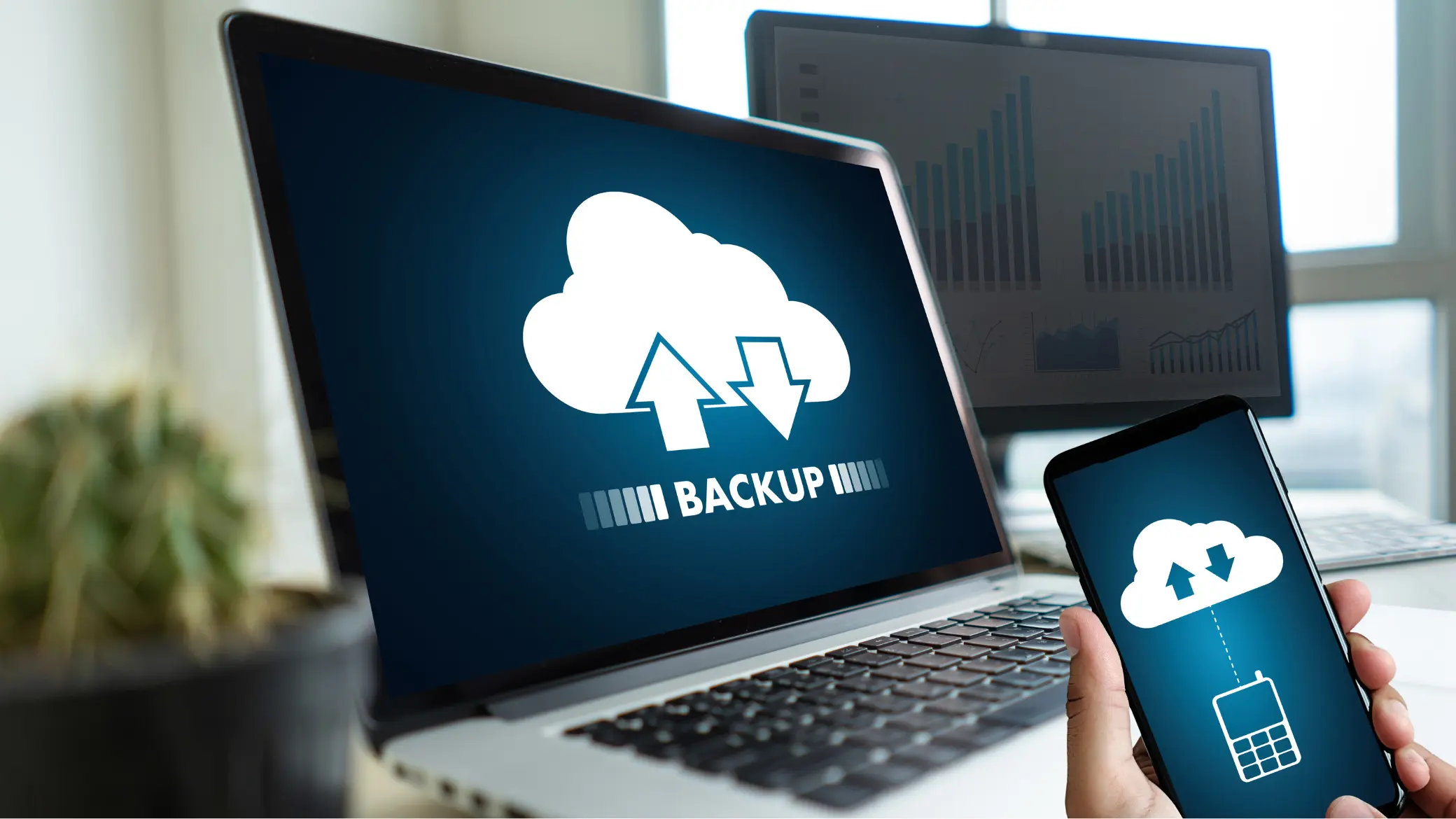
What is the Importance of Data Backup and Recovery Services?
Are you concerned about the security of your digital assets? Or do you just have to wake up at night worrying about what might happen to them?
Many business owners have experienced sleepless nights due to the uncertainties surrounding backup and recovery which can undermine their sense of security. This ongoing anxiety can divert your attention from crucial priorities such as the growth of your business.
With a managed IT service provider that understands the importance of data backup and recovery solutions, your business can undergo a transformative change. A data backup and recovery strategy ensure business continuity bolsters your ability to respond effectively when you need it most.
Together we can assist you in implementing and exploring tailored data backup and recovery services that meet your specific requirements.
What is Data Backup and Recovery?
It is a process of replicating data, storing it elsewhere to deal with loss and damage, and then retrieving it at a point in time to have it available again for operations-either back to the original location or some safe alternative. Ideally, backup copies-sometimes referred to as snapshots-are immutable, meaning they cannot be altered after they are created to protect against modifications such as ransomware.
Backup and recovery is also a type of on-premise and cloud technology capable of automating and facilitating this process so that organizations can effectively protect and retain their data for business or compliance purposes.
Types of Data Backup and Recovery Services
The backup and recovery service fit into many categories, each meant for different uses and applications. Usually, this includes:
- Full Backup
This refers to the process where all of the data is copied from the given system/server to a backup location. Full backups take an entire snapshot of the data; hence, all files should be backed up.
- Incremental Backup
Incremental backups save only those files that have been changed since the last backup, whether that backup was a full or incremental. This technique will save time and save on space utilization, but recovery requires the previous backups.
- Differential Backup
The differential backup includes all changes made since the last full backup. While this type of backup requires more storage with each cycle than incremental backups do, it also makes recovery simpler since you only need your last full backup and the most recent differential backup.
- Mirror Backup
A mirror backup means an exact copy of the data, like a full backup. Therefore, it makes every mirror backup up-to-date with the original; the changes in the original will automatically appear on the backup.
- Cloud Backup
Cloud-based backup solutions store data at condensing limit on offsite remote servers, either by an individual or an organization, because of their scalability, accessibility, and ease-of-use.
- Local Backup
Involves backing up the data on local physical devices, such as external hard drives, network-attached storage (NAS), or tapes. Local backup provides faster recovery but lacks offsite protection.
- Hybrid Backup
A hybrid backup solution mixes local and cloud storage, allowing for on-site and offsite backups to prevent data loss due to disasters.
- Continuous Data Protection (CDP)
CDP allows for the continuous backup of data in real-time, making a copy of every change made in the system as soon as it’s made. With continuous backup, one minimizes the risk of data loss at the ultimate expense of storage.
- Tape Backup
This is one of the oldest backup options; it takes magnetic tapes to back up data. It remains one of the go-to options for enterprise level because of economical considerations but is much slower than the following methods.
- Disk-Based Backup
Disk-based backup stores data as backups on hard drives or other storage disk drives. This makes them faster than tape backups, and they are widely used in all forms of home, office, and enterprise solutions.
- Offsite Backup
Offsite backups take data outside of a location, either via physical transport (e.g., external hard drives) or via cloud services. This protects data from local disasters such as fire or theft.
- Bare-Metal Recovery
This is a method of restoring the entire system, including the operating system, applications, and data, onto the clean system without pre-installed software. It’s useful in the event of a total system failure.
- Snapshot Backup
Snapshot backups take a “snapshot” of the system at a point in time. This enables quick backups and restores by capturing the state of the system at a point in time.
All these services have their own merits, and opting for one will be determined based on a recovery time objective, storage space, and data criticality.

Who Needs to Use Data Backup and Recovery Services?
Organizations cannot stake their good luck fortunes on managing huge volumes of information through project management systems. There is a need for regard to avoiding risks of loss of project data and for security consciousness.
The reason is that backup data backup and recovery systems should be of priority for every organization collecting, storing, and exhibiting sensitive and essential data, which include businesses, government institutions, hospitals, schools, and other organizations that heavily rely on data to carry out their functions.
Organizations that collect data from their customers, such as online stores or insurance agencies, take on a huge risk as well as a huge responsibility to protect their consumer’s data.
With the introduction of personal data privacy laws, most organizations have a greater responsibility to protect and safeguard their client’s data against any loss or theft. This is why, despite all the other concerns, they just should not ignore backup matters.
Advantages of Data Backup and Recovery
All losses in data can affect an individual in major ways. So having a way of creating, implementing, and reverting any services for project management in itself has many benefits.
Let us take a look at some of the major advantages of data backup and recovery solutions.
- Data Security
Data backup and recovery infers data security primarily. The importance of good data backup and restoration solutions offers paramount protection to the organization’s project management system or information.
Reliable data backup and recovery services actually provide you with multiple layers of protection against threats like data sprawl and data breaches for your organization. They are also essential for maintaining customer data safety and supporting regulatory compliance.
- Restoration and Replication of Data
The primary purpose of data backup is to recover and restore data at any time. An organization can reduce downtime with an efficient recovery system that allows it to continue operations without interruptions.
Youngsters tend to happen across this feature more with data backup and recovery apps. This feature reveals its processes by taking real-time copies of your project data and saving it, giving you peace of mind regarding the security of its data.
- Simplified Data Management
Data recovery is influenced by many variables to successfully recover data; however, a good backup solution will make the whole job easy. It offers scheduled backups and customized strategies for project management platforms to safeguard against errors and permit quick recovery from emergencies.
- Financial Oversight
Losing critical data can disrupt operations and lead to legal issues, project delays, and financial losses. While backup solutions may seem expensive, investing in data protection is of great importance for the present and future sustainability of your company.
- Uninterrupted Performance
Manual data backup methods are well slow and require much more time, keeping servers busy the whole time. Automated backup systems enhance network performance, reduce storage costs, and allow the uninterrupted operation of large organizations without slowed performance.
- Elevated Competitive Advantage
In the enlightened age of data-asset management, acquiring effective facilities for managing will become the key to an organization’s competitive growth.

Differences Between Modern and Traditional Data Backup and Recovery Solutions
| Modern Solutions | Traditional Solutions |
|---|---|
| Use advanced technologies like cloud storage, hybrid systems, and deduplication. | Use physical media like tapes, disks, or external drives. |
| Offer real-time or near-real-time backups (e.g., Continuous Data Protection). | Typically operate on scheduled backups (e.g., daily, weekly). |
| Faster recovery with instant access to cloud or hybrid backups. | Recovery can be slow, especially from physical media like tapes. |
| Cloud solutions enable global reach and collaboration. | Accessibility may require physical transport of media. |
| Pay-as-you-go pricing models for cloud storage. | High initial costs for hardware and physical media. |
| Cloud providers often offer compliance with global security standards. | Limited encryption and access control mechanisms. |
| AI-driven analytics and automation streamline the backup process. | Requires manual management and oversight. |
Choosing the Right Data Backup and Recovery Solution
Data backup has been defined and verified as the careful process needed by one’s business organization. Good data protection solutions should be in place for all businesses, and here are some major factors you ought to consider:
- Backups Frequency
Frequent backups ensure that all of your latest data is backed up. Pick a schedule that works for your business-they may be daily, weekly, or real-time.
- Backup Type
Select between on-site, off-site, or cloud backups. Combinations of these (hybrids) give maximum protection from data loss.
- Scalability
It should grow along with the growth of the company. Newer implementations, such as cloud storage, work for growing data requirements.
- Data Encryption
The sensitive data contained in your backups needs to be encrypted. Otherwise, they are vulnerable to unauthorized access.
- Recovery Speed
Check the duration required to have the data back up and available in the event of a loss. Recovery time determines the amount of downtime and disruption.
- Automation of Processes
Choose backup software that will automate the backup processes, rather than manning handles of the duty itself, in order to turn this into a simpler and safer way.
- Testing and Validation
You should be testing backup and restoration process regularly, and they should work without earth shattering effects when they are needed.
- Compliance and Regulators
Choose a solution that complies with the data protection principles within your industry standards to avoid any form of penalization.
We offer all of these solutions with exceptional expertise. If you’re looking for the best cloud backup services in 2025, look no further—count on us! Reliable data backup and recovery systems are essential for your business, and we’re here to ensure you’re always protected.